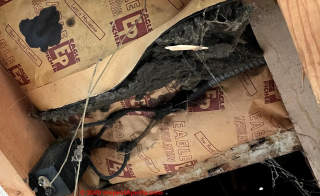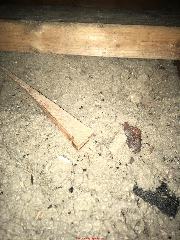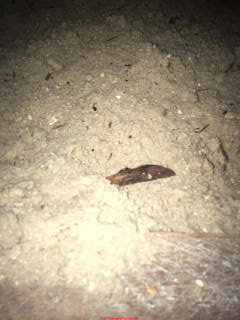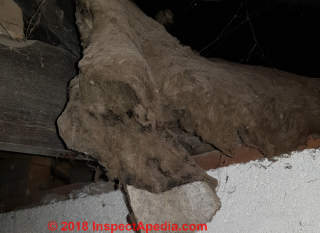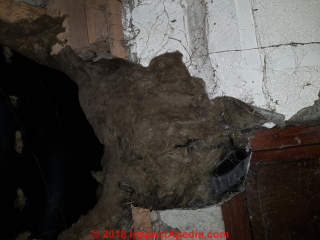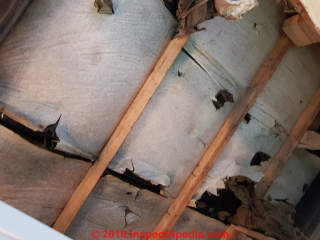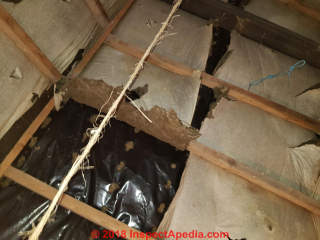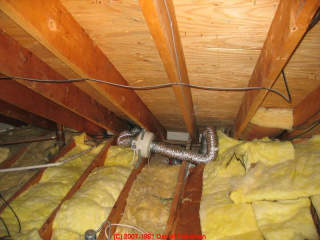 Insulation FAQs
Insulation FAQs
Questions & answers about insulation
- POST a QUESTION or COMMENT about identifying & troubleshooting building insulation & ventilation systems
Building insulation guide to selection, installation, inspection, troubleshooting, & improvement: this article series discusses how to inspect, diagnose and correct problems in building insulation or ventilation systems.
We also describe how to install or repair building insulation & ventilation systems including using stains and other clues to diagnose air movement, heat loss or moisture problems.
InspectAPedia tolerates no conflicts of interest. We have no relationship with advertisers, products, or services discussed at this website.
FAQs about Building Insulation: methods, materials, contaminants, problems
These questions and answers about building insulation identification, installation, methods, materials, choices, values, and problems were posted originally at INSULATION INSPECTION & IMPROVEMENT - topic home, a page where we give a complete index to articles about each type of insulation.
You may enjoy scanning that information for more in-depth guidance.
On 2020-12-12 - by (mod) - black fiberglass (or rock wool) insulation: Eagle Pitcher EP Insulation asbestos?
Eagle Pitcher Industries, founded in the U.S. in 1842, produced a wide range of products including white lead products, batteries, and industrial insulation. Up to ca 1976 the company also produced asbestos-containing products for which ultimately an asbestos settlement trust was formed in 1996. The company filed for bankruptcy protection in 1996 and again in 2005.
The company is still in business. Its current products do not contain asbestos.
Your insulating material appears to be a black fibre, probably mineral wool or possibly fiberglass. That material is not likely to contain asbestos as a deliberate ingredient.
Please see details about EAGLE PITCHER ASBESTOS PRODUCTS where we describe the asbestos-containing products that EP produced.
Generally fiberglass insulation does not contain asbestos unless by cross-contamination.
But these 3 articles may be of interest
ASBESTOS INSULATION inspectapedia.com/hazmat/Asbestos_Insulation.php
ASBESTOS IN MINERAL WOOL / STONE WOOL inspectapedia.com/insulation/Mineral-Wool-Asbestos.php
ASBESTOS STYROFOAM PANELS inspectapedia.com/hazmat/Asbestos-in-Styrofoam.php
I'll preserve your photo and this discussion at
BLACK FIBERGLASS INSULATION?
and welcome your further questions & comments
- Contact: EaglePitcher Technologies, EaglePicher Headquarters
120 S. Central Ave.
Suite 200
St. Louis, MO 63105
USA, Tel: 417-623-8000 Website: https://www.eaglepicher.com/
On 2020-12-11 by Robert
I found this insulation [photo above] manufactured by Eagle Picher.
Doing some research I found they made many concrete products containing asbestos but can't find anything definitive on insulation.
Its a dark grey/black color. Any input to what it is?
The building was initially built in the late 20's in California but has gone through many re-models/additions since then so not exactly sure of the age.
On 2020-11-15 by Mike R
I was creating an access space into my attic and came across the insulation pictured. It is yellow, fluffy and breaks apart super easily. It looks like cotton, but it breaks apart. House is in south coastal Massachusetts built in 1925.
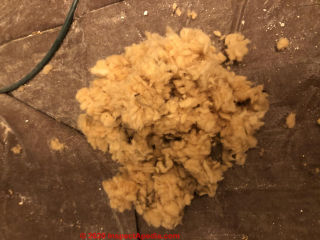
On 2020-11-13 - by (mod) -
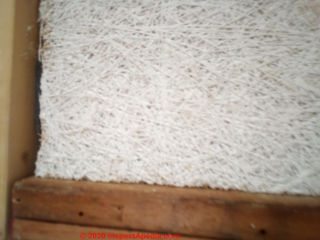 Robin: That looks like a wood fibre faced insulating panel;
Robin: That looks like a wood fibre faced insulating panel;
it's not at a;; likely to be an asbestos product but we cannot say with certainty from your photo alone.
More photos (you sent later by email) would be helpful as well as a bit more information about the building where this insulation was found.remodeling history.
1. what does the edge of the material look like
2. how about the back side of it
3. if it can be removed intact in panels in any case it's easy enough to remove and bag with low risk of stirring up dust as would be made by more aggressive methods like chopping or sawing.
Knowing more information like building age, location, remodeling history, can help make a smart guess.
Beyond that, if you cannot inspect further and must make a dusty mess then treat the material as presumed to contain asbestos or have a sample tested.
Later this afternoon you'll find your question and a more-detailed reply at
https://inspectapedia.com/insulation/Wood-Fiber-Insulating-Panels.php
On 2020-11-13 by Robin Smith
Hello ... I bought an older home and found insulating panels in the walls that look like wood fiber with a white coating. Can you please advise if it is safe or needs to be removed? Thank you.
On 2020-09-02 - by (mod) -
Think about using solid foam insulating board and you can get to some pretty high R values
On 2020-09-01 by Michael Russo
I need to insulate the attic of a gambrel roofed garage. 2x6 trusses don't leave a lot of options for the sloping parts of the roof. There is a LOT more space above the 8 foot long roof rafters and I do not think it will be hard to get the necessary R-49 in the ceiling, But the 2x4 studs at either end and those trusses provide a challenge. ANY viable suggestions are appreciated!
On 2020-07-25 by Anonymous
How thick is the board that the
Siding is attached to
On 2020-06-24 - by (mod) -
Dustin
Your photos of Johns-Manville Spinsuation are now found at
FIBERGLASS INSULATION IDENTIFICATION & PROPERTIES - properties for a key to identifying fiberglass building insulation brands & products.
https://inspectapedia.com/insulation/Fiberglass_Insulation_Identification.php
in that article at PINK FIBERGLASS INSULATION https://inspectapedia.com/insulation/Fiberglass_Insulation_Identification.php#Pink
thank you again
On 2020-06-24 - by (mod) -
Anon
Apologies, but I don't see your photo: you can post but one photo per comment, but as many comments as you need.
On 2020-06-24 by Anonymous
From front (bottom) to back (top)
Ceiling tile (a chipboard material nailed down. Tested and not hot)
Planks to support tiles
Insulation bags
2nd picture you can see the exposed insulation from a bag that presumably popped
Thanks
On 2020-06-24 - by (mod) - Johns-Manville Spinsuation
Dustin
Your photos of Johns-Manville Spinsuation are now found at
FIBERGLASS INSULATION IDENTIFICATION & PROPERTIES - properties for a key to identifying fiberglass building insulation brands & products.
in that article organized by insulation color,
at PINK FIBERGLASS INSULATION
thank you again
On 2020-06-24 - by (mod) -
Anon
Apologies, you can post but one photo per comment, but as many comments as you need.
On 2020-06-24 by Anonymous
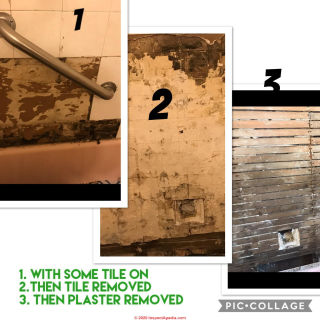 From front (bottom) to back (top)
From front (bottom) to back (top)
Ceiling tile (a chipboard material nailed down. Tested and not hot)
Planks to support tiles
Insulation bags
2nd picture you can see the exposed insulation from a bag that presumably popped
Thanks
On 2020-05-16 - by (mod) -
For clarity, can you name the layers of wall materials in order?
Thanks.
On 2020-05-16 by Jodeen
It actually wasn’t in the floor. It was in the walls in the upstairs bathroom. The 2 walls I removed were due to tiles having moldy grout but as I revived the tiles the previous owner placed drywall on top of the plaster and lath.
The 2 walls are on the north west corner of the house on the exterior most in our 1915 stucco 2 story house I live in Milwaukee Wi. Hope that helps your research.
On 2020-03-04 by Anonymous - John Manville approved Rock Wool Home Insulation Form #Hi 82 contains asbestos?
Ted
We've published what we know on this question at ASBESTOS IN MINERAL WOOL / STONE WOOL
Please take a look and let me know if any of that is unclear.
On 2020-03-04 by ted
my house is old and would like to know if John Manville approved Rock Wool Home Insulation Form #Hi 82 contains asbestos?
On 2020-02-23 - by (mod) - using closed cell foam insulation in a remodeling job
Sounds like an application for closed cell foam insulation and taking care not to create air-spaces or cavities into which moist indoor air might leak, moisture become trapped, and thus a metal roof or wall sheathing corrosion problem ensue.
On 2020-02-23 by carl
I am remodeling an old gas station in northern Ca. climate zone 16, high/low34-78 100 in. rain, snow every 20 years. I have not found comprehensive info for insulating existing STEEL walls/ceilings for conditioned space, I can add insulating foam inside or outside.
On 2019-04-25 - by (mod) - is there asbestos in my fiberboard panels?
Please see
SHEATHING, FIBERBOARD ASBESTOS CONTENT
also because your insulating board looks gray in colour
see CANEBOARD PANELS
and let me know if that leaves you with further questions
On 2019-04-25 by Vern
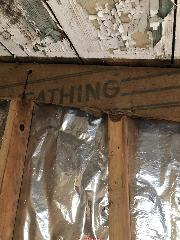 Do you think it has asbestos in it?
Do you think it has asbestos in it?
also the paint on the ceiling pic is coming down and it's old . I don't know if there's asbestos in it . That paint was a old car port that they through a ceiling in it and closed it in . That being said with the constant heat any paint would peal like that after a while wouldn't it ? Thanks for your help
On 2019-04-25 - by (mod) -
It looks like a fiberboard insulation product. Fiberboard is a wood or cellulose-based insulating product.
On 2019-04-25 by Vern
Here is another one it's 3/4 inch thick
IMAGE LOST by older version of Clark Van Oyen’s useful Comments code - now fixed. Please re-post the image if you can. Sorry. Mod.
Question:
19 March 2015 Steve said:
I'm trying to ID some attic insulation I have.
I see it (darker yellow, foam chunk looking) clearly depicted in the top photo of this page (inspectapedia.com/insulation/Insulation-in-Buildings.php) but what I don't see anywhere is a statement or description of what that image is showing?
Thank you kindly
fatire155ATGEEEMAIL.COM
Reply:
Steve
The page top photo shows two generations of fiberglass - chopped and lighter yellow batts.
On 2018-11-12 by (mod) - Closed cell foam forms its own vapor barrier.
Closed cell foam forms its own vapor barrier. You don't generally want a wall with multiple layers of vapor barrier because you can trap moisture between them.
On 2018-11-12 by Colton
I'm looking for some insight into how I should insulate my container home from here. I have an inch of closed cell foam sprayed across so far. But should I add a vapor barrier on the ouside with rigid foam between or typical fiberglass batts?
IMAGE LOST by older version of Comments code - now fixed. Please re-post the image if you can. Sorry. Mod.
On 2018-09-30 by (mod) -
Enlarging your second photo that looks to me like dirty fiberglass with a kraft paper wrapping. If you gently separate the edge of the material to show its interior I'm betting we're going to see pink fiberglass.
Any idea of the age of the material or age of the building and ductwork?
On 2018-09-30 by Anonymous
here is another picture.
IMAGE LOST by older version of Comments code - now fixed. Please re-post the image if you can. Sorry. Mod.
On 2018-09-30 by (mod) -
IT
The photo is a bit blurry and distant to be very confident but the insulation looks a lot like a cellulose or fiberboard product with a white paper or plastic exterior. Check that the white papery material is or is not asbestos paper.
You can use the search box just above to search this site for ASBESTOS PAPER INSULATION to see photos.
On 2018-09-30 by Insulation type
Hi. Wondering if you can tell me what type of insulation is wrapping the ductwork (appears brown with white or light color backing and falling apart) Home was built in 1952.
IMAGE LOST by older version of Comments code - now fixed. Please re-post the image if you can. Sorry. Mod.
On 2018-04-17 by DJQ
Hello was reviewing your web site for some guidance but did not see what I needed. Was going to ripe off the siding on a 1965’s Split Level house down to the studs from the outside and was going to use Rock wool batts followed by ½” plywood, Tyvek house wrap and vinyl siding. Question is the vapor barrier, how and what kind to use if any?
On 2017-09-17 by (mod) -
Hannah
Use the page top or bottom CONTACT link to send me some sharp photos of the panels from several feet away and then close-up and I can comment further.
Yes IB probably means insulated board.
It certainly won't be "pure asbestos" in any case.
On 2017-09-17 by Hannah
Thank you Dan! My confusion is that I don't think it looks like this. ..it's not really a white/ cement/powdery material.... to me it looks more like a woody material like beaver board sprayed black with the gold bond stamp on.
It's very fibrous, brown grey in color. I can't see any info on gold bond making beaver board. I'd asumed that IB stamped on it meant insulation board. I'm hoping that it is woody and not pure asbestos fibers. ...the wall in question has a door we use frequently that has it exposed ..
.it's sandwiched between drywall/plaster, and it seems to be worn away in part, it's by our main living area, and the rest is uncovered by plaster or wall and open in the electrical cupboard. our house is wood frame. we have one room upstairs and one room downstairs so we have to remove this part of the house to add a room for our toddler now.
On 2017-09-16 by (mod) -
Hannah,
Current Gold Bond gypsum board panels (produced by National Gypsum Corporation) are a fiberglass reinforced gypsum panel intended for moisture resistant or exterior wall cladding use. See details
at SHEATHING, GYPSUM BOARD https://inspectapedia.com/structure/Gyp_Rock_Sheathing.php
Some of these products did contain asbestos up to 1970. Gypsum board made by National Gypsum after 1970 did not contain asbestos.
Therefore if the renovations performed on your farmhouse were made in just that year (1970) it is certainly possible that older stock, containing asbestos, was used in the home.
There is often more asbestos in joint compound than in the wallboard itself; the hazards do not come from intact, un-damaged, in place drywall that is undisturbed - asbestos hazards are not like radioactivity. But if the wallboard is being cut, sawn, ground, chopped, broken-up, demolished so as to make dust there is a possible asbestos hazard. If such work is unavoidable in your home then you'll want to
use the on-page InspectApedia.com search box to find our list of ASBESTOS TEST LABS to have a small sample tested to guide your demolition work.
See ASBESTOS in DRYWALL at https://inspectapedia.com/hazmat/Asbestos_in_Drywall.php
for details.
On 2017-09-16 16:21:49.870075 by Hannah
I have discovered some Gold Bond Panels in our electric room, they look fibrous- black painted - I guess insulation boards. On the black paint they are marked Gold Bond IB rated AL82, the house is a 1900s farm house, had some renovation to that area of the house 1n 1970 - I'm concerned these boards may contain asbestos?
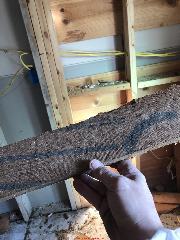 On 2019-04-25 by (mod) - grayboard building sheathing is not an asbestos product
On 2019-04-25 by (mod) - grayboard building sheathing is not an asbestos product
Usually these products don't use asbestos - with a few exceptions.
Please see
SHEATHING, FIBERBOARD ASBESTOS CONTENT
also because your insulating board looks gray in colour
see CANEBOARD PANELS
and let me know if that leaves you with further questions
On 2019-04-25 y Vern
 also the paint on the ceiling pic is coming down and it's old . I don't know if there's asbestos in it . That paint was a old car port that they through a ceiling in it and closed it in . That being said with the constant heat any paint would peal like that after a while wouldn't it ? Thanks for your help
also the paint on the ceiling pic is coming down and it's old . I don't know if there's asbestos in it . That paint was a old car port that they through a ceiling in it and closed it in . That being said with the constant heat any paint would peal like that after a while wouldn't it ? Thanks for your help
Do you think it has asbestos in it?
On 2019-04-25 by (mod) - can you identify this 3/4" thick insulating board?
It looks like a fiberboard insulation product, probably grayboard building sheathing - a paper-like material made from cellulose, in some cases from cane. See details
On 2019-04-25 by Vern
Here is another one it's 3/4 inch thick - photos above -
Hi do you know what this insulation is ?
Here is a few pics I don't got much left of it .
On 2019-03-08 by (mod) -
Yes I have found RARE cases of asbestos used as general insulation in attics and walls, discussed and illustrated in this article series.
On 2019-03-08 by Anonymous
I meant to add below that this was aside from vermiculite being used as loose fill. Thanks.
On 2019-03-08 by Steve
Was curious to know if loose fill asbestos was ever used in the United States in residential homes. I heard about this having been used in Australia, but curious if this was ever something that was done in the U.S.
On 2019-03-05 0 by (mod) - remains of kraft facing from insulation
Most likely the Bits of Paper that you're describing was a Kraft paper facing on insulation but of course I can only guess. It would be nice to see a photo of what you're talkin about.
On 2019-03-04 2 by Steve
Had recently replaced floor trim on inside wall of my 1977 house.
Saw what looked like a small amount of fluffy insulation that had some small bits of brown paper ( like the color of cardboard or packing paper) mixed in with it.) what I am seeing is definitely not vermiculite.
Was curious if the bits of brown paper mixed in with this fluffy stuff have any clues as to what is. Could it be an asbestos product? Live in Connecticut, USA. Thank you
On 2019-01-18 by (mod) -
sicut ante dictum
On 2019-01-18 by Cam - is this not vermiculite?
So not vermiculite?
Heres another snapshot.
On 2019-01-18 by (mod) - loose-fill cellulose in a 1911 Ontario home
That looks like cellulose insulation, loose-fill - most-likely a retrofit insulation job added well after the 1911 year of your home's original construction
On 2019-01-18 by Cam
Anyone able to give this product an identification?
-Found in attic space.
-House built in 1911
-Located in Southern Ontario (Canada)
I realize that only a lab analysis can definitively identify what lurks beneath (ie. Asbestos), however, I am having trouble determining if this is even vermiculite at this point.
On 2018-11-30 by (mod) - looking for a MA company that tests insulation
Linda you need to define what kind of test is needed: identification, contamination, adequacy of insulation, effectiveness.
Mold contamination? R-value?
As those are different skills and procedures.
On 2018-11-02 by Linda
I am trying to find a company here in Massachusetts that does testing on insulation.
On 2018-11-30 by (mod) - insulation testing
Linda you need to define what kind of insulation test is needed: identification, contamination, adequacy of insulation, effectiveness.
As those are different skills and procedures. In other words, what problem are we solving?
For example see
INSULATION MOLD CONTAMINATION TEST
and
LAB IDENTIFICATION OF FIBERGLASS
On 2018-11-02 by Linda
I am trying to find a company here in Massachusetts that does testing on insulation.
On 2018-08-30 by (mod) - found multiple layers of ceiling structures and attics - fire hazard
Dennis
I have run into what sounds like the same situation. Your house may have been constructed originally with a flat roof. Owners got tired of leaks and built a pitched roof overtop the flat roof. Your cut-through found the original flat tar and gravel roof.
Watch out: building or fire codes generally don't permit nor like buildings that add layers of constructed roofs atop one another because it makes fighting a fire more dangerous and more difficult. For example the fire fighters can't vent smoke out of a building by the standard method of cutting a hole in the roof, since there's another roof below.
Details are at CONCEALED SPACE FIRE CODES https://inspectapedia.com/roof/Concealed-Space-Roof-Construction.php
On 2018-08-30 by Dennis
Just bought a house built in 1955. It had no attic access so I built one. When I cut through the drywall ceiling I came upon what looked like another ceiling.
I cut through this.
It was about 4 inches thick and had what looked like a thin black tar layer on the attic side.
When I finally poked my head into the attic I found that there was an uneven amount of what looked like pea stones scattered about the top. All the houses in this area of the Midwest were built as track housing all with the same specifications.
Was this material intended to be the ceiling or was it insulation? Trying to identify what it is.
On 2018-01-22 by mark - photos of mineral fiber insulation for identification
hi will have a look, if it is mineral wool or rock wool did that ever contain asbestos?
On 2018-01-21 by (mod) - tell me what sort of insulation this is
Mark
While the long fibres look like fiberglass, we might be looking at very dirty, dusty old mineral wool batt insulation. Mineral wool is quite similar to fiberglass.
MINERAL WOOL - ROCK WOOL INSULATION
Take a look at any kraft paper backing on the insulation and photograph any brands or markings if you come across them.
On 2018-01-21 by mark
another close up photo
thank you, that's what I thought too but it's completely grey. never seen in grey before. but also never heard of paper backed asbestos on a roll lol.
On 2018-01-19 by (mod) -
Mark
That looks like fiberglass or (less likely) a mineral fiber insulation.
On 2018-01-19 by mark
hi can anyone tell me what sort of insulation this is, my boss at work thinks it's paper backed fiberglass.
says it was put in outhouse about 35 years ago. it looks like fiberglass to me but it's completely grey and its paperbacked. has anyone else seen this type of insulation. did fiberglass insulation ever have asbestos in? or was it ever grey?
Been working in this out house for about 3 years and the insulation is damaged all over. so a little concerned, my boss assures me it's fiberglass but would like a second opinion.
On 2017-12-14 by Patty A.
Thank you!
On 2017-12-14 by (mod) - start with the air filter
I would start with the air filter: making sure that its mount isn't leaky, that the filter is clean, and that you're using the highest level of filtration you can without creating a low-pressure or airflow problem in your HVAC system. With good filtration the system ought to be lowering, not raising the indoor dust levels.
If the ducts are fiberglass-lined and were mechanically cleaned they could have been damaged - another thing to check.
On 2017-12-14 by Patty A. - why my eyes get itchy and irritated when I run my HVAC heating system
I commented in separate reply because Id didn't see the reply to this comment until after.
Just trying to troubleshoot why my eyes get itchy and irritated when I run my HVAC heating system.
Both the heater and the ducts are fairly new. The ducts are flexible type. ...anyway, so the air intake from the heating system doesn't pull air in from the attic or walls when it runs?
On 2017-12-14 by (mod) -
If you suspect the building dust as the irritant, which is reasonable given your description, you might want to send a tape sample of dust to a forensic lab to ask them to identify dominant particles as well as any unusual irritants.
Try finding labs at the page top EXPERTS DIRECTORIES or you can of course do your own google search.
On 2017-12-14 by Anonymous
Thanks Dan. My ducts and heating system are fairly new so I can't image them having leaks. Just trying to troubleshoot why my eyes are irritated and itcy when I run my heating system. Maybe just blowing dust from the house up in general.
On 2017-12-14 by (mod) -
Patty, the sparkly fibers you see could be fiberglass but also they could be other fabric fibers.
Though there are a few technical exceptions that cause attic air to move down into occupied space, usually air is moving up into the attic from below, riding the stack effect (warm air rises).
Fiberglass dust would not normally be pulled from an attic into the living area unless there are air return duct leaks into HVAC ducts that run through that space, or perhaps human traffic moving dusty items into the occupied space from the attic.
It is normal for us to find some fiberglass fragments in most building dust samples, but it is not normally the dominant particle. Dominant are normally fabric fibers and skin cells - in house dust.
On 2017-12-14 by Patty A.
When I wipe my hand along my floors, and then go out and look at my hand in the sunlight I see a lot of fibers that sparkle. Some are long and some are just specs. Would this be a indication of some fiberglass being pulled into my home from my attic, perhaps by my duct system, which is in my attic?
On 2017-09-15 by Hannah
I have discovered some Gold Bond Panels in our electric room, they look fibrous- black painted - I guess insulation boards. On the black paint they are marked Gold Bond IB rated AL82, the house is a 1900s farm house, had some renovation to that area of the house 1n 1970 - I'm concerned these boards may contain asbestos?
On 2017-06-03 by (mod) - is steel dryer vent OK to use against polystyrene insulation
Ron
at CLOTHES DRYER VENT CLEARANCES & TERMINATION inspectapedia.com/Appliances/Clothes_Dryer_Vent_Clearances.php
we discuss clearance distances required for clothes dryer vents.
At the end of that article I've repeated your question and provided a detailed reply citing research and authoritative sources. Please take a look and let me know if you have further questions or comments.
On 2017-06-03 by Ron
is steel dryer vent OK to use against polystyrene insulation
Question:
(Mar 19, 2015) Steve said:
Hi there,
I'm trying to ID some attic insulation I have.
I see it (darker yellow, foam chunk looking) clearly depicted in the top photo of this page
INSULATION INSPECTION & IMPROVEMENT but what I don't see anywhere is a statement or description of what that image is showing?
Thank you kindly
fatire155ATGEEEMAIL.COM
Reply:
Steve
The photo shows two generations of fiberglass - chopped, darker golden brown fiberglass, and lighter yellow fiberglass insulation batts.
There is also a lot of wooden debris atop the insulation, suggesting that probably a wood shingle roof was replaced and workers (unavoidably) dropped scrap and trash into the attic.
Look closely [click to enlarge any image] and you may notice that insulation does not come to the top of the joists that form both the attic floor and support for the ceiling below. This home may need more insulation, depending on where it's located.
Before adding insulation I'd prefer to remove the wooden trash. And if there is a chance that during that roofing work the fiberglass insulation got wet I'd replace it. (Search InspectApedia.com for FIBERGLASS INSULATION MOLD to see why I say that).
Question: Does Johns Manville Spintex insulation contain asbestos and what's its R-value?
(May 3, 2015) Dan said:
Does John Manville Aluminum Wrapped Spintex batt Insulation (with aluminum foil on one side and paper on the other side) contain asbestos and what would be the R value.The insulation is from the 1950's.
There's a number on the aluminum side Hl-131B
Reply:
From the Johns Manville Spintex insulation citations we've found to date, the product refers to a mineral fiber or "rock wool" insulation - not an asbestos material.
The R-Value for Mansville Spintex was about 4.8 per inch before allowing for the effects of insulation gaps or material inconsistencies.
You can see advertisements for Mansville's Spintex in Life Magazine LIFE Oct 6, 1958 - I include a photo in our Rock Wool Insulation
article - ASBESTOS IN MINERAL WOOL / STONE WOOL
and detail about this specific insulation product is
at SPINTEX MINERAL WOOL PROPERTIES - MANSVILLE
The R-values for mineral wool or "rock wool" insulation are given
at MINERAL WOOL / STONE WOOL R-VALUES.
(May 3, 2015) Dan said:
The front of the batt insulation is all aluminum(looking)and does not have the words rock wool.
it says: John Manville Aluminum Wrapped Spintex Insulation along with installation instruction and drawing.It doesn't look cottony- it looks more like fiberglass and has a very slight crunch when squeezed. Thanks Again
Dan
(mod) said:
Dan
I found Mansville's own description of Spintex as well as advertising data both describing it as mineral wool. Take a look at the Rock wool insulation link I provided earlier.
Also if you can, please find my email at our CONTACT link at page bottom and send me some sharp photos of your insulation in place and closeups of its marks or labeling, and a closeup of the insulation material itself. You can also mail me a sample if you like, we'll take a look at it in the lab (pro bono).
Question: yellow foamy stuff dripping down the building exterior in Dallas
June 27, 2015) Sharon said:
There is a strange yellow scrambled-egg like foamy substance suddenly forming and dripping down building exterior from above the top floor of my apartment building. Building approximately 10 years old; I've lived here 3 years and never seen anything like it. No recent maintenance done to exterior that I'm aware of and I'm home all day. Is it more likely to be spray foam insulation squeezing out or mold? Located in Dallas area which recently had a lot of rain. I have photos but don't see an option to post them.
Reply:
I do not know, Sharon. It is not at all likely that previously-installed foam insulation would now be dripping out of the building.
An onsite expert will consider the location of the yellow foamy stuff, what mechanical equipment or other stored items are near and above that point, and then she'd examine those as possible sources. I'd also look for a honeybee colony in the wall.
Question: ok to install a bath vent fan when there's vermiculite in the attic?
(July 12, 2015) P. Durocher said:
Is it possible to install a new bathroom ventilator in a attic that contains vermiculite (containing asbestos) in a safe manner, OR
we absolutely have to take out all isolant of the attic before (prio to) the remplacement of the ventilator ?
Thank you
Reply: vent the bath fan to outdoors and don't track vermiculite debris and dust into the building.
Certainly you can install a bath vent fan and run the duct to the outdoors via an attic. Workers need to wear proper gear and you want to take care not to track dust and debris down into the house (or to clean it up if you do).
Use a HEPA vacuum and damp wiping to clean up any dust spills.
See VERMICULITE INSULATION - home
Also see WHAT TO DO ABOUT VERMICULITE INSULATION
Question: safe to remove balsam wool insulation ?
(Oct 2, 2015) Susan said:
Can I safely remove balsam wool insulation as a home project and replace it with fiberglass. The black paper is torn in many areas and falling.
Reply:
Yes, taking normal precautions against breathing dust.
See BALSAM WOOL BATT INSULATION
Question: ok to leave space in an insulated wall?
(Oct 7, 2015) Michael said:
I want to frame a 2x8 exterior wall but only required to put in 6" thick insulation.
Will there be a problem if there is a space between insulation and drywall or do I need to fill insulation for full depth of the wall stud?
Reply:
Michael:
Provided you don't have air leaks into and out of the wall, you can leave a space as you describe. In fact with some insulating products, such as products using a reflective facing, leaving a still-air space in the wall cavity will increase the total R-value of the wall.
Over at FOAM BOARD INSULATION TYPES you'll see some examples of increases in R-value for an added air space.
Question: best way to ventilate an attic around a hinged roof rafter in a modular home
(May 5, 2016) Phil said:
What's the best way to ventilate around a hinged roof rafter in the attic of my modular home?
The footer type framing just above the ceiling doesn't allow for much room for the baffles to extend far enough into the attic from each knee wall. Should I just clear as much blown in insulation away from the little bit of exposed baffles or is there a way to get around that footer?
Would it be safe to drill a couple three .5 inch holes in that footer to allow for better air flow beyond the baffles?
Reply:
1/2" holes won't move enough air to have an effect on attic ventilation, Phil.
But I also don't want to remove insulation as that creates a cold spot above the exterior walls and may increase the risk of ice damming. Long baffles should improve the problem, or you can use my labor-intensive but more effective approach of tacking furring strips to the upper sides of the rafters, then installing solid foam insulation between rafters.
The 1 1/2" or larger air space between rafter and the upper side of the solid foam forms a more effective (and more pricey) air passage
Question: leak caused water to run out of a ceiling fan, now my dog almost died and I had to go to the ER
(Sept 11, 2016) Anonymous said:
I had a leak that caused water to run out of my ceiling fan - no problems. The roof was fixed by guys who work for my landlord. No problem.
Then it poured down rain for about 5 minutes hard. Immediately I felt skin burning eyes nose throat severely irritated. I felt like a truck was on my chest causing me to not be able to take a full breath. I looked at my light fixtures and it looked like tiny pieces of glass on it. Mom saw it and I left. Been to ER 4 times and my dog almost died. I was breathing these particles for about 2 weeks cause no one saw what me and mom saw.
They checked in the day with no bright light. they didnt check the attic or duct work. Could my insulation somehow have gotten stirred up and in the air? Keep in mind they are tiny pieces. I did wipe some on a sponge to show dad. He also got sick.
Who can I talk to? My landlord is done but I can't even go home now. He says I can move but this is all over all of my belongings. Everything is contaminated. HELP PLEASE
Reply:
Anonymous
You need to start review of these worries with your doctor. If your doctor agrees that there was an environmental cause or aggravate her, then it might be worth having inappropriate environmental test lab examine representative dust settles from you're home.
If the material is fiberglass then HEPA vacuuming and cleaning would be appropriate before moving carpets furniture and such and so forth from your home.
From just your text one cannot know what hazards are present in your home - or might be. But certainly if insulation got wet it could also be moldy, as could the cavity side of ceilings or walls covered in drywall if water ran in those areas. There could be a problematic (big) mold resevoir in your home.
See MOLD in FIBERGLASS INSULATION
...
Continue reading at INSULATION INSPECTION & IMPROVEMENT - topic home, or select a topic from the closely-related articles below, or see the complete ARTICLE INDEX.
Or see these
Recommended Articles
- INSULATION AIR & HEAT LEAKS
- INSULATION IDENTIFICATION GUIDE
- INSULATION INSPECTION & IMPROVEMENT - topic home
- INSULATION LOCATION - WHERE TO PUT IT
Suggested citation for this web page
INSULATION IDENTIFICATION FAQs at InspectApedia.com - online encyclopedia of building & environmental inspection, testing, diagnosis, repair, & problem prevention advice.
Or see this
INDEX to RELATED ARTICLES: ARTICLE INDEX to BUILDING INSULATION
Or use the SEARCH BOX found below to Ask a Question or Search InspectApedia
Ask a Question or Search InspectApedia
Try the search box just below, or if you prefer, post a question or comment in the Comments box below and we will respond promptly.
Search the InspectApedia website
Note: appearance of your Comment below may be delayed: if your comment contains an image, photograph, web link, or text that looks to the software as if it might be a web link, your posting will appear after it has been approved by a moderator. Apologies for the delay.
Only one image can be added per comment but you can post as many comments, and therefore images, as you like.
You will not receive a notification when a response to your question has been posted.
Please bookmark this page to make it easy for you to check back for our response.
Our Comment Box is provided by Countable Web Productions countable.ca
Citations & References
In addition to any citations in the article above, a full list is available on request.
- In addition to citations & references found in this article, see the research citations given at the end of the related articles found at our suggested
CONTINUE READING or RECOMMENDED ARTICLES.
- Carson, Dunlop & Associates Ltd., 120 Carlton Street Suite 407, Toronto ON M5A 4K2. Tel: (416) 964-9415 1-800-268-7070 Email: info@carsondunlop.com. Alan Carson is a past president of ASHI, the American Society of Home Inspectors.
Thanks to Alan Carson and Bob Dunlop, for permission for InspectAPedia to use text excerpts from The HOME REFERENCE BOOK - the Encyclopedia of Homes and to use illustrations from The ILLUSTRATED HOME .
Carson Dunlop Associates provides extensive home inspection education and report writing material. In gratitude we provide links to tsome Carson Dunlop Associates products and services.


